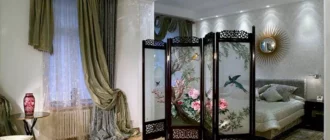
Modern in the interior: the philosophy of naturalness in an elegant form
The Art Nouveau style in the interior is easily recognizable: smooth rounded “natural” lines, complex shapes, asymmetry, a lot of wood and light, original decor and soft colors.
Modern in the interior is a modern classic, which is usually chosen by people who are not alien to creative professions, who appreciate the beauty of wildlife and strive to embody it in their home. To understand what Art Nouveau is, it is enough to recall the amazing houses of Gaudi, which he made part of the surrounding landscape, and the paintings of Klimt.


The main characteristics and features
The Art Nouveau style made a splash in its time, destroying the classical canons, completely changing the idea of how the interior should look like in a liquid. It became an alternative to classicism, which by that time had practically exhausted itself. Art Nouveau has a special aesthetics and expressiveness.

The basics of Art Nouveau in the interior include:
- Main idea. Here, each element is part of a single whole, a fragment that, if removed from the composition, will cause it to collapse.
- Forms. In Art Nouveau there are no rigid lines, angles and clear geometry. The forms are elegantly smooth and graceful, natural. This is a general principle that is followed by all elements of the interior, from arched doorways, lamps, curved legs and backs of chairs, and ending with stained glass compositions. At the same time, in the interior, as in the creations of nature, there is no rigid symmetry.
- Materials. Art Nouveau widely uses wood and stone, metal and glass, gypsum and natural fabrics. Forged railings, huge stained-glass windows in arched windows, stone or plaster columns – all this is designed to create a feeling of spaciousness, freedom and unity with nature.
- Color. The style is characterized by natural, natural shades, gentle and designed to restore peace of mind. The colors of sea sand and baked milk, caramel and chocolate, white, pearl gray, lilac, peach, blue and pink dominate. Black and graphite, blue and purple, anthracite and wenge are chosen as contrasting inserts.
- Light. There is always a lot of light in the modern interior. Huge wall-to-wall windows, many intricately shaped lamps, chandeliers and floor lamps provide good illumination of the room. The streams of light are flowing, neat and soft, like clouds. They are absolutely not intrusive.
- Furniture. As a rule, objects of complex shapes, decorated with carvings with floral ornaments, are selected. Upholstered furniture – sofas and armchairs – are quite massive, the color of the upholstery is often selected based on the shade of the walls.
- Textile. Fabrics are an indispensable element of Art Nouveau or, as it is also called, Tiffany style. Draped curtains and light curtains on the windows, decorated with lambrequins and picked up by cords, carpets with floral patterns, upholstery of armchairs and sofas, decorative pillows and the like.
- Decor. As for jewelry, in modernity they have a special relationship. There is no abundance of knick-knacks, decorative elements are “built into” the interior itself. Their role is played by forged openwork railings, floral ornaments on wallpaper, luxurious stained-glass windows, carvings, stucco molding on the ceiling and walls, ceramic tiles and bas-reliefs. Favorite motifs in Art Nouveau decor are maidens with long curly hair, plants and intertwined tree branches.


The history of modernity in the interior
Art Nouveau originated at the end of the 19th century, so calling it “modern” can be a stretch. The new style absorbed the ideas of archaic and gothic, Egyptian and Quattrocento. Decorators who created Art Nouveau were inspired by Baroque and Rococo, Empire and Japanese ukiyo-e prints.
Modern style has many synonyms. Among them are such as: Art Nouveau, Art Nouveau, Studio, Liberty, Spruce style, Secession and others. Luxurious Tiffany-style is also based on Art Nouveau. The symbol of the direction and the embodiment of the most characteristic features of the design was the embroidery of the decorator Herman Obrist – a golden floral ornament on a blue fabric. She received the name “Alpine Violets”, but, with a light hand of criticism, she changed her name to “Blow of the Scourge.”


Initially, serious battles unfolded around Art Nouveau, which corrected and offended the laws of classicism. He was admired and branded, considered divine and called the height of bad taste. Nevertheless, the ideas and images of Art Nouveau spread like wildfire.
Nicholas II also delivered a verdict on modernity. Having visited an exhibition of architecture, the tsar wrote in his diary: “they examined the rooms in a new, filthy style.” It is curious that in post-perestroika times, modernity was passionately loved in Russia – it was associated with the lost pre-revolutionary romance and the era of the last Romanov.

World War I marked the end of the Art Nouveau era. No, he didn’t die completely. Only bright non-standard personalities, creative people and looking down on conventions decided to decorate their houses in this style. However, the 21st century came and brought modernity back to the pedestal. Today, Art Nouveau is one of the fashionable types of design. He was finally appreciated.

































